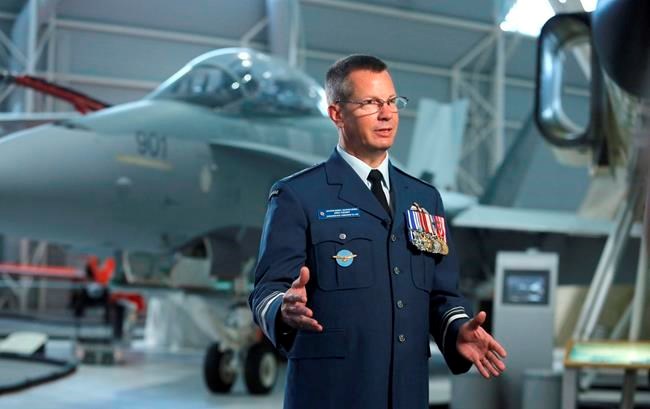OTTAWA — A police investigation into comments made at a social gathering of fighter pilots in June has cast a spotlight on a well-known but little-understood military tradition that some worry is another example of entrenched cultural problems in Canada’s Armed Forces: the assignment of call signs.
Earlier this week, Royal Canadian Air Force commander Lt.-Gen. Eric Kenny announced that he was delaying a ceremony to install a new commander at one of Canada’s two fighter-jet bases, 3 Wing in Bagotville, Que.
Kenny attributed the decision to an ongoing military police investigation into statements made during what he described as a “call sign review board” held on June 22 at Canada’s other CF-18 base, 4 Wing in Cold Lake, Alta.
Many people would know call signs from the blockbuster "Top Gun" movies, in which Tom Cruise’s character is nicknamed “Maverick.” That call sign is a reference to the character’s refusal to follow orders and play by the military’s rules.
Canadian fighter pilots also use call signs. Anyone who has been to an air show in Canada and got a close look at a Snowbird or CF-18 might have seen the pilot’s call sign written with their real name near the cockpit.
While call signs aren't the exclusive domain of pilots, they aren't widely used in other parts of the Royal Canadian Air Force.
The air force says call signs help build a sense of team and identity among fighter pilots and break down barriers between different rank levels. They also benefit communications in the air.
Assigning call signs “is meant to foster esprit de corps,” said RCAF spokesman Lt.-Col. Adam Thomson. “The call sign has a practical purpose and is used for brevity and quick identification while removing some flight leadership barriers that may arise by rank or position.”
While call signs can spring up organically like any other nickname, call sign review boards like the one under investigation are a key way that they are assigned.
Despite their official-sounding name, such gatherings are social events where pilots tell stories about each other.
“Call signs are typically assigned at a unit social gathering in a location like a mess or unit social area,” Thomson said in an email.
“Often these stories recount a challenge, instance or success particular to a member. These stories inspire an individual’s call sign. Possible call signs are suggested by peers and are voted on by the group.”
Former fighter pilots say such events often involve tossing back drinks while throwing around stories about new aviators – the funnier or more embarrassing the better.
“And after one, two or three beers, if there was a funny story or a good one, the call sign would be adopted,” said former air force commander and retired lieutenant-general Yvan Blondin, whose call sign is Bad.
Former chief of the defence staff and retired general Tom Lawson, call sign Shadow, put it another way: “It’s a mini-roast is what it is.”
Such events are typically held at the end of significant training courses or exercises with senior officers on hand, which Blondin said gives the process a “semi-formal twist.” As for the other details, both former pilots said they can often vary from unit to unit.
“When we talk about a process, there's nothing formal, there's nothing in the books, there's nothing in our procedures, that says this is the process as a requirement for call signs,” Blondin said. “It doesn't exist.”
The results of such gatherings aren’t always positive. While many call signs refer to mistakes in training or personality quirks, Blondin gave one extreme example of a pilot years ago whose call sign involved a crude description of a sexual encounter.
Thomson said the air force recently conducted a review of existing call signs to determine their appropriateness “while directing that future call signs aligned with our commitment to be an inclusive organization.”
Yet it’s unclear the degree to which that review touched on the process for assigning call signs, including the conduct of review boards – which appears to lie at the heart of the ongoing military police investigation in Cold Lake.
“There’s probably a lot less alcohol than in the ‘70s and ‘80s, which makes it easier for everybody to stay on this side of the line,” Lawson said. “But it appears someone at one of these reviews was made ill at ease by a comment, or a comment was made well across the line.”
Lori Buchart, co-chair of It’s Not Just 20K, a support and advocacy group created by victims of military sexual misconduct, said it is important for the Canadian Armed Forces have rituals and traditions to build a sense of identity and boost spirits.
“The important thing for the CAF and its members is to root out the ones that cause harm or are questionable, and keep those ones that actually build morale in a healthy way,” she added.
Charlotte Duval-Lantoine of the Canadian Global Affairs Institute, who recently released a book on military sexual misconduct, said the current situation should start a discussion on how call signs are assigned to Canadian fighter pilots – and how it can be done better.
“Call signs and the way they are assigned can reveal a lot about the culture of a unit,” she said. “And like with any culture, it can go too far and take the form of bullying and berating, especially if the person receiving the call sign does not fit in the group as well as others.”
At the same time, Duval-Lantoine said the issue highlights some of the difficulties the military faces in eliminating inappropriate conduct given the various traditions that exist among different units and positions within the Armed Forces.
While both Lawson and Blondin hope call signs remain a fixture among Canadian fighter pilots, Blondin acknowledged there may be a need to impose some type of structure or control over review boards.
“I wouldn't want to get rid of them,” he said. “But I think we need some formalization. In the days we're living in now, some of the stuff is certainly not acceptable the way it is.”
This report by The Canadian Press was first published Sept. 3, 2022.
Lee Berthiaume, The Canadian Press
Note to readers: This is a corrected story. A previous version incorrectly said weapons officers fly on two-person CF-18s, but those aircraft are only used for training. The previous version also provided a wrong rank for Lt.-Col. Adam Thomson.



